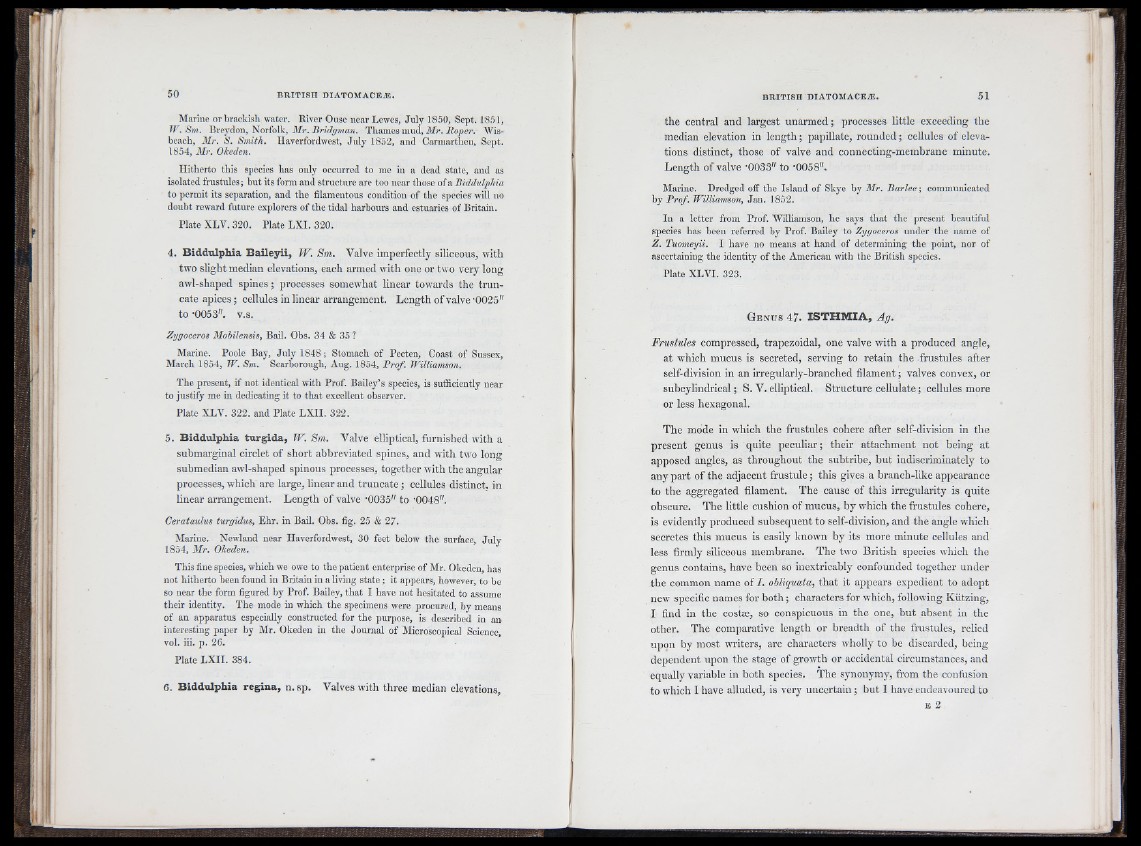
m
jMavine orbrackisli water. River Onse near Lewes, July 1850, Sept. 1851,
JI'. Sm. Rreydon, Norfolk, J/r. JiWrfi;»;««. Thames mud, M»’. iioper. Wis-
beach, Mr. S. Smith. Haverfordwest, July 1852, and Carmarthen, Sept.
1854, Mr. Okeden.
Hitherto this species has only occurred to me in a dead state, and as
isolated frustules; but its form aud structure are too near tliose of a Biddulphia
to permit its separation, and the filamentous condition of the species will no
doubt reward future explorers of the tidal harbours and estuaries of Britain.
Plate XLV. 320. Plate LXI. 320.
4. Biddulphia Baileyii, W. Sm. Valve Imperfectly siliceous, with
two slight median elevations, each armed with one or two very long
awl-shaped spines; processes somewhat linear towards the truncate
apices; cellules in linear arrangement. Length of valve '0025"
to -0053". v.s.
Zygoeeros Mobilensis, Bail. Obs. 34 & 35 ?
Marine. Poole Bay, July 1848; Stomach of Pecten, Coast of Sussex,
March 1854, TV. Sm. Scarborough, Aug. 1854, Prof. TVilliamson.
The present, if not identical with Prof. Bailey’s species, is sufficiently near
to justify me in dedicating it to that excellent observer.
Plate XLV. 322. and Plate LXII. 322.
5. Biddulphia turgida, TV. Sm. Valve elliptical, furnished with a
submarginal circlet of short abbreviated spines, and with two long
submedian awl-shaped spinous processes, together with the angular
processes, which are large, linear and truncate ; cellules distinct, in
linear arrangement. Length of valve ‘0035" to -0048".
Cerataulus turgidus, Ehr. in Bail. Ohs. fig. 25 & 27.
Marine. Newland near Haverfordwest, 30 feet below the surface, July
1854, Mr. Okeden.
This fine species, which we owe to the patient enterprise of Mr. Okeden, has
not hitherto been found in Britain in a living state; it appears, however, to be
so near the form figured hy Prof. Bailey, that I have not hesitated to assume
their identity. The mode in which the specimens were procured, by means
of an apparatus especially constructed for the purpose, is described in an
interesting paper by Mr. Okeden in the Journal of Microscopical Science,
vol. iii. p. 26.
Plate LXII. 384.
6 . Biddulphia regina, n. sp. Valves with three median elevations.
the central and largest unarmed ; processes little exceeding the
median elevation in length ; papillate, rounded ; cellules of elevations
distinct, those of valve and connecting-membrane minute.
Length of valve '0033" to •0058",
Marine. Dredged off the Island of Skye by Mr. Barlee ; communicated
by Prof. TVilliamson, Jan. 1852.
In a letter from Prof. Williamson, he says that the present beautiful
species has been referred by Prof. Bailey to Zygoeeros under the name of
Z. Tuomeyii. I have no means at hand of determining the point, nor of
ascertaining the identity of the American with the British species.
Plate XLVI. 323.
G e n u s 47. IS T HM IA , Ag.
Frustules compressed, trapezoidal, one valve with a produced angle,
at which mucus is secreted, serving to retain the frustules after
self-division in an irregularly-branched filament ; valves convex, or
suboylindrical ; S. V. elliptical. Structure cellulate ; cellules more
or less hexagonal.
The mode in which the frustules cohere after self-division in the
present genus is quite peculiar; their attachment not being at
apposed angles, as throughout the subtribe, but indiscriminately to
any part of the adjacent frustule; this gives a branch-like appearance
to the aggregated filament. The cause of this irregularity is quite
obscure. The little cushion of mucus, by which the frustules cohere,
is evidently produced subsequent to self-division, and the angle which
secretes this mucus is easily known by its more minute cellules and
less firmly siliceous membrane. The two British species which the
genus contains, have been so inextricably confounded together under
the common name of I. obliquata, that it appears expedient to adopt
new specific names for both ; characters for which, following Kützing,
I find in the costæ, so conspicuous in the one, but absent in the
other. The comparative length or breadth of the frustules, relied
upon by most writers, are characters wholly to be discarded, being
dependent upon the stage of growth or accidental circumstances, and
equally variable in both species. The synonymy^, from the confusion
to wliich I have alluded, is very uncertain ; but I have endeav oured to
E 2